
Preserved lemons are a classic old preservation recipe. They are not meant to be eaten pure, as they are far too salty. But in small doses, they are such an enrichment to dishes! Now that I know how good they are, I always want to have a supply of them in my kitchen! With their fermented fruity and salty flavor, they always add a special touch. I’ve tried them in salads, sauces, and simple dishes – always delicious. For some dishes, a small lemon slice of lemon is already enough. They can also work as a substitute for fresh lemon zest. Or add a few tablespoons of the juice, which also works deliciously in sauces. But be aware that these lemons are pungent; experiment slowly with the amount in your dishes.
After blending a batch of preserved lemons, it’s become my absolute favorite. It’s so convenient to use while cooking, and the dosage is even better.
The preserved lemons are very popular in Moroccan and Middle Eastern cuisine. I’m happy to have discovered them and to share this recipe with you.
Making preserved lemons is easy. All you need is organic lemons, salt, sugar, a glass weight, a preserving jar, and time. Patience is key for this recipe: they need to steep for 3-4 weeks to ferment properly!
Ingredients for making Preserved Lemons:
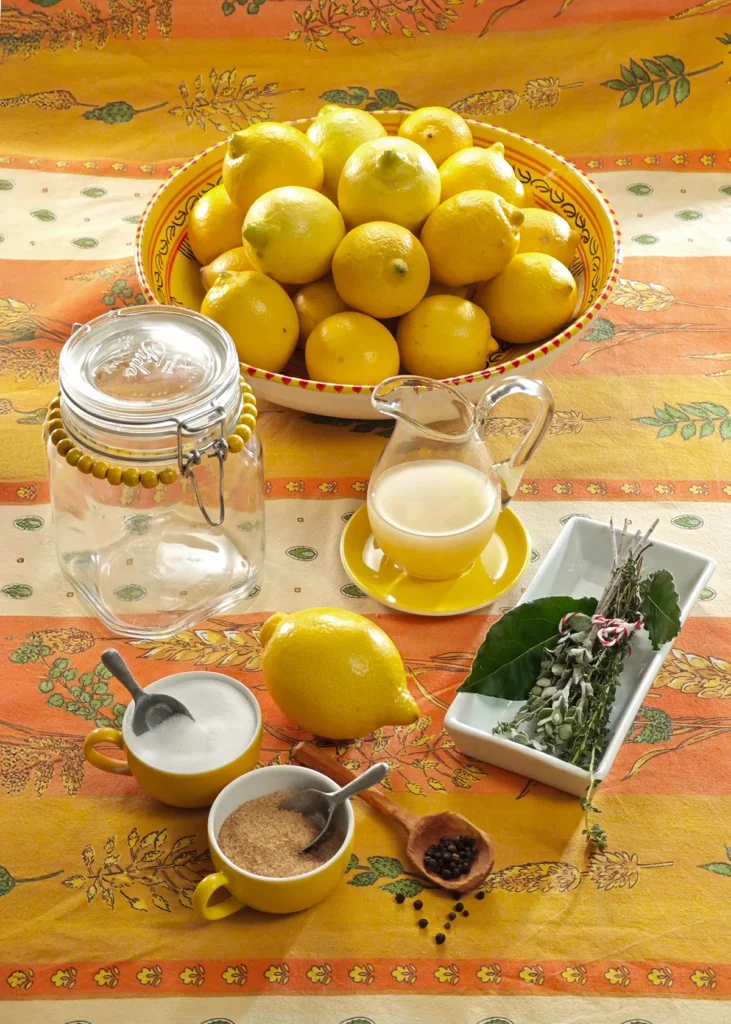
- Organic lemons
- Salt, natural untreated
- Sugar
Optional Decoration:
- Thyme
- Oregano
- Bay leaf
- Peppercorns
Needed Equipment:
- Preserving jar with wire jar and rubber ring
- Glass fermentation weights (or a small glass bowl)
Weights: The lemons must always be covered with brine, otherwise mold could develop. This is why they have to be pressed down with special glass fermentation weights. For me, it works just as well with a small glass bowl. Please do not use any plastic or metal objects.
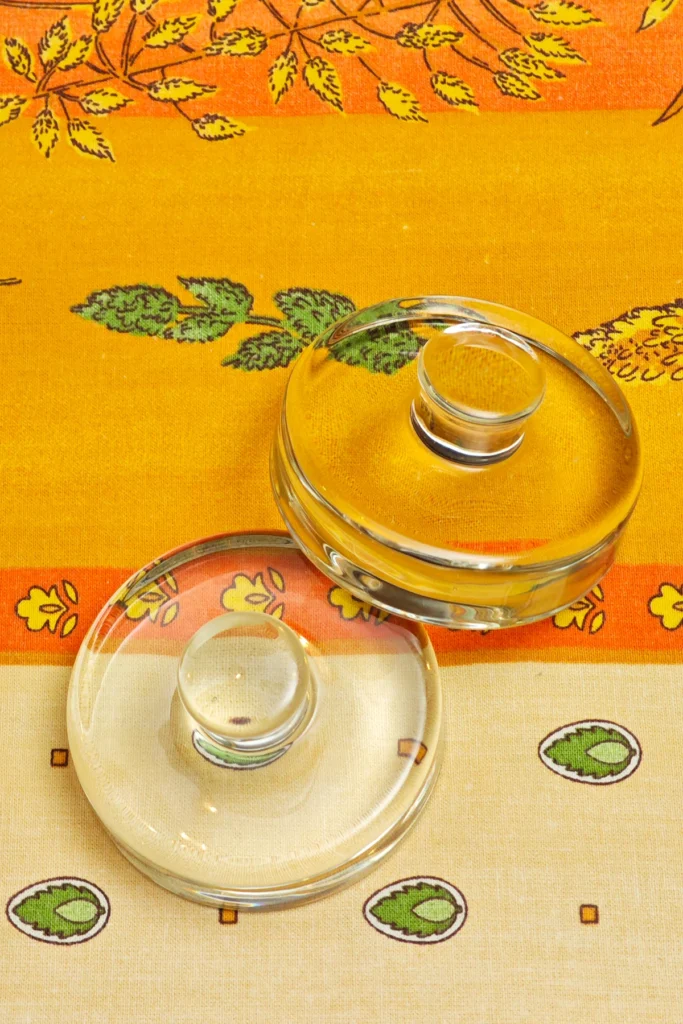
Wash out the preserving jar with hot water before using it. Hygiene is the most important thing when preserving!
How to make Preserved Lemons:
Here’s a short tutorial video that quickly explains the recipe:
Preparing the Lemons:
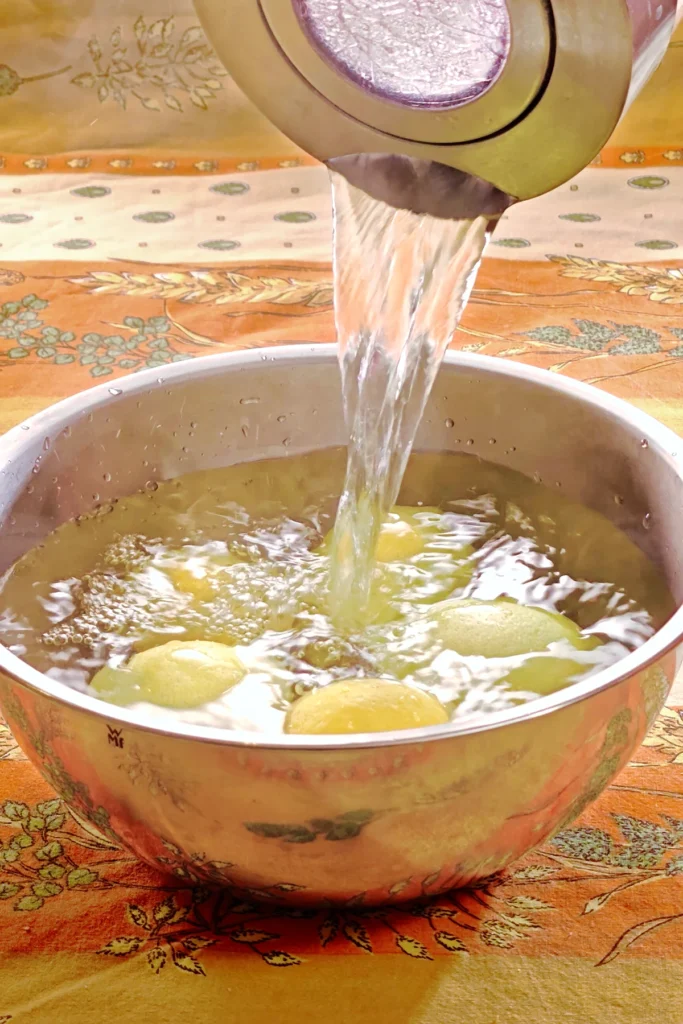
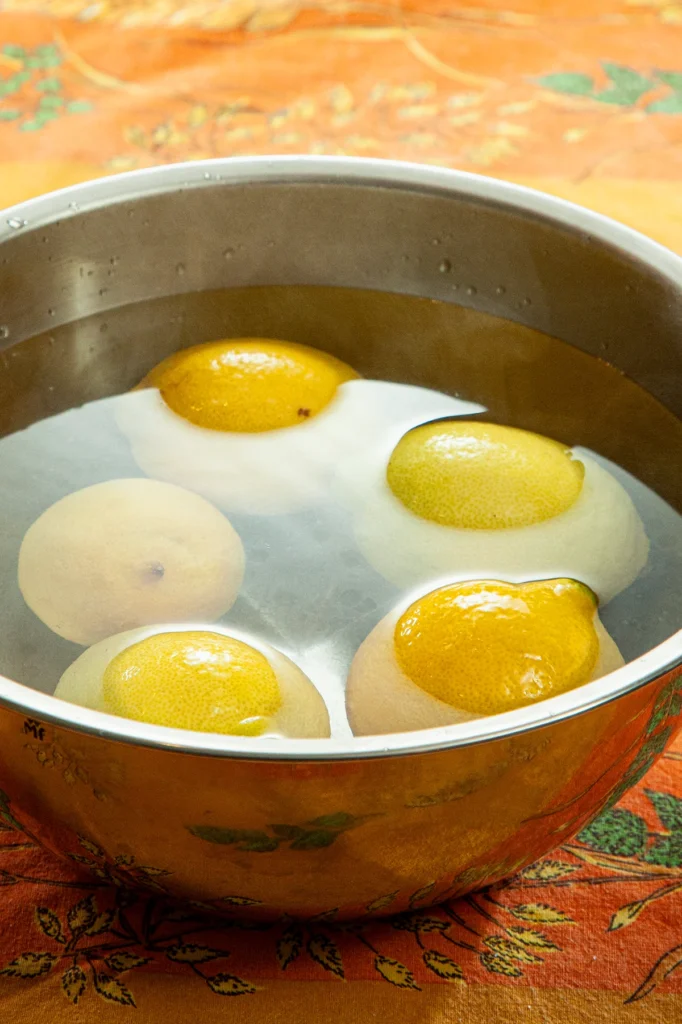
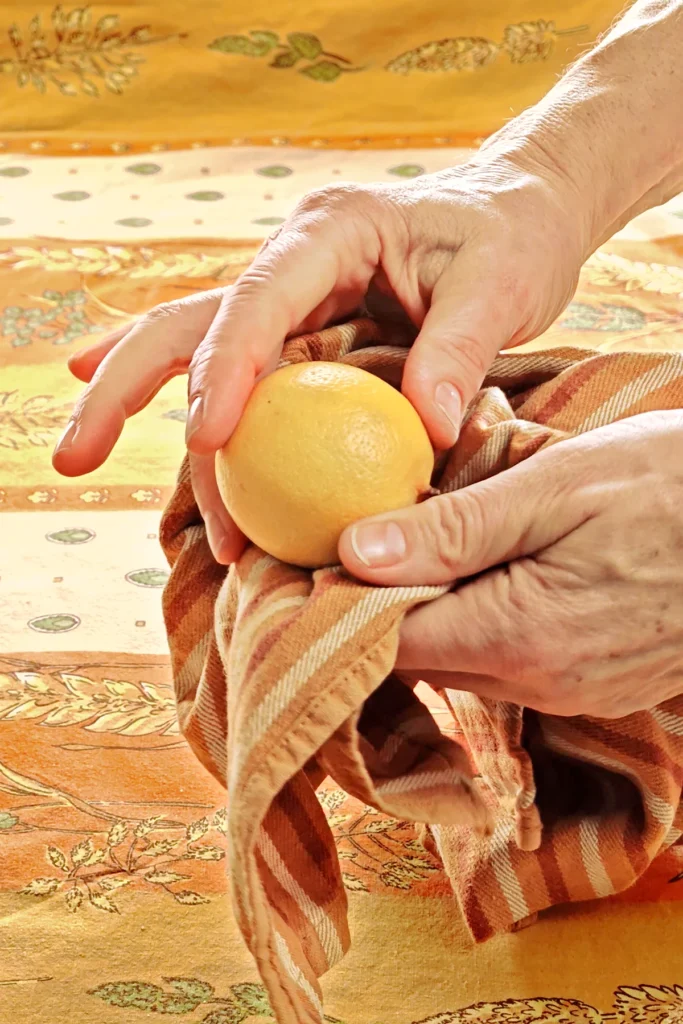
Even though organic lemons are supposed to be untreated, you should wash them with hot water. Then, rub them dry to remove the natural wax layer that every lemon has. So, we start our canning process with a large bowl of hot water and add our lemons. Then, rub them dry with a kitchen towel.
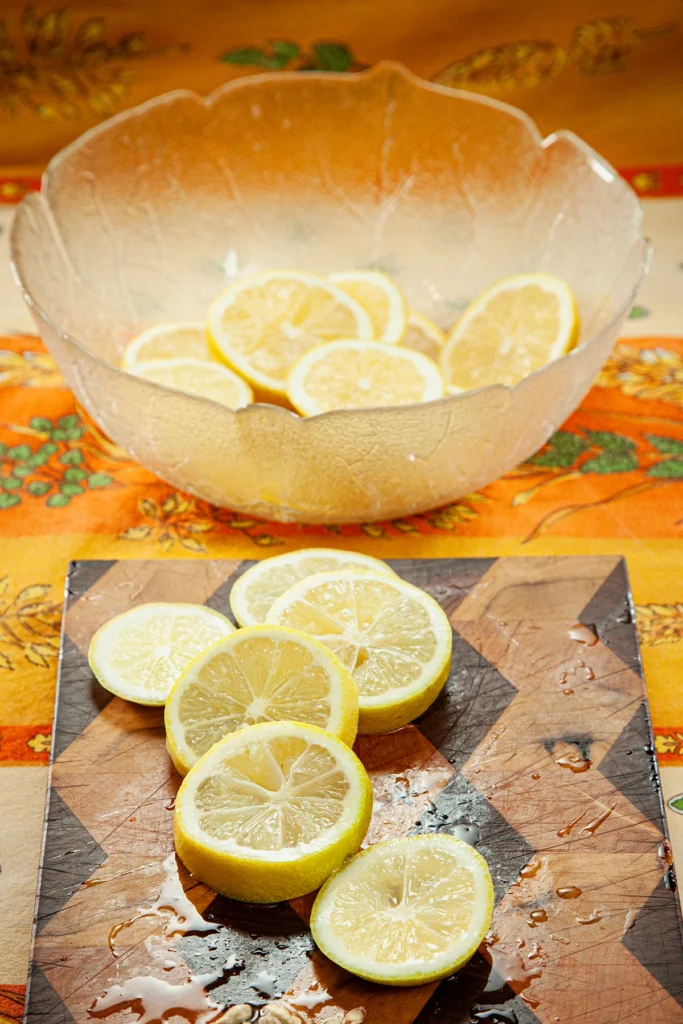
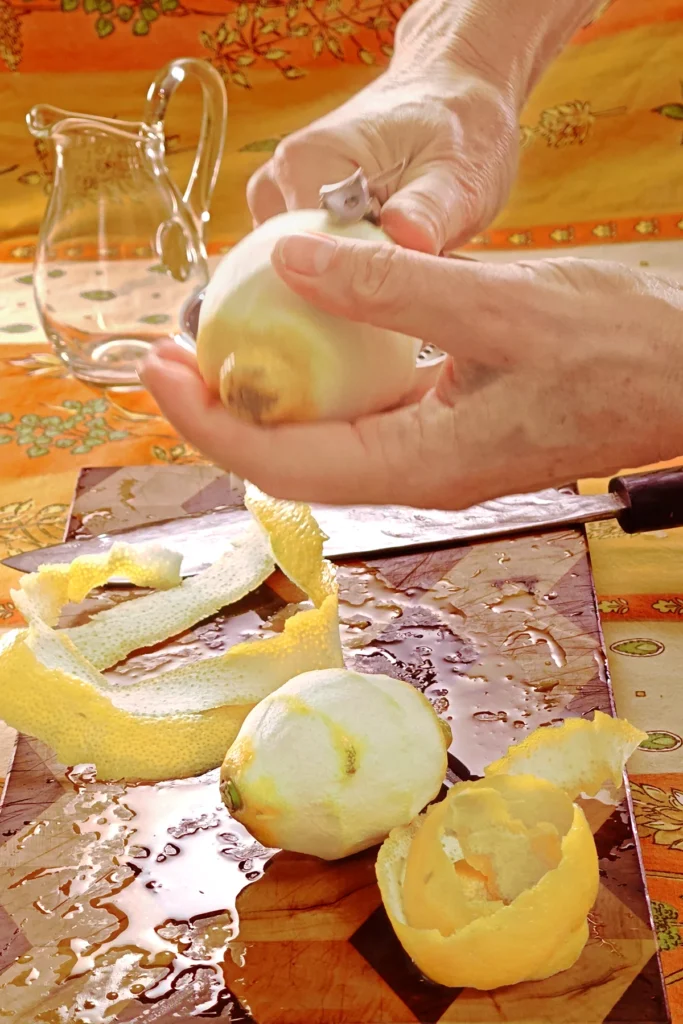
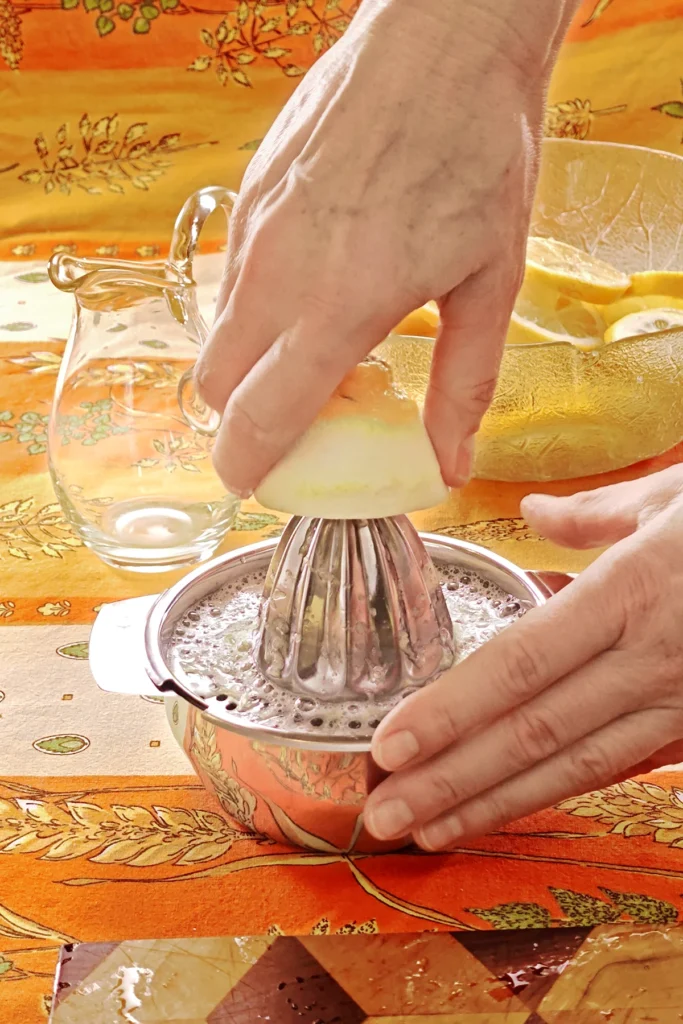
Next, cut four lemons into slices about 4-5 millimeters (approx. 2 inches) thick. Remove the seeds and discard the end pieces. Peel the remaining two lemons with a potato peeler and add the peel to the lemon slices. Now squeeze the juice out of these two peeled lemons with a citrus juicer – set aside for now.
Filling the Preserving Jar:
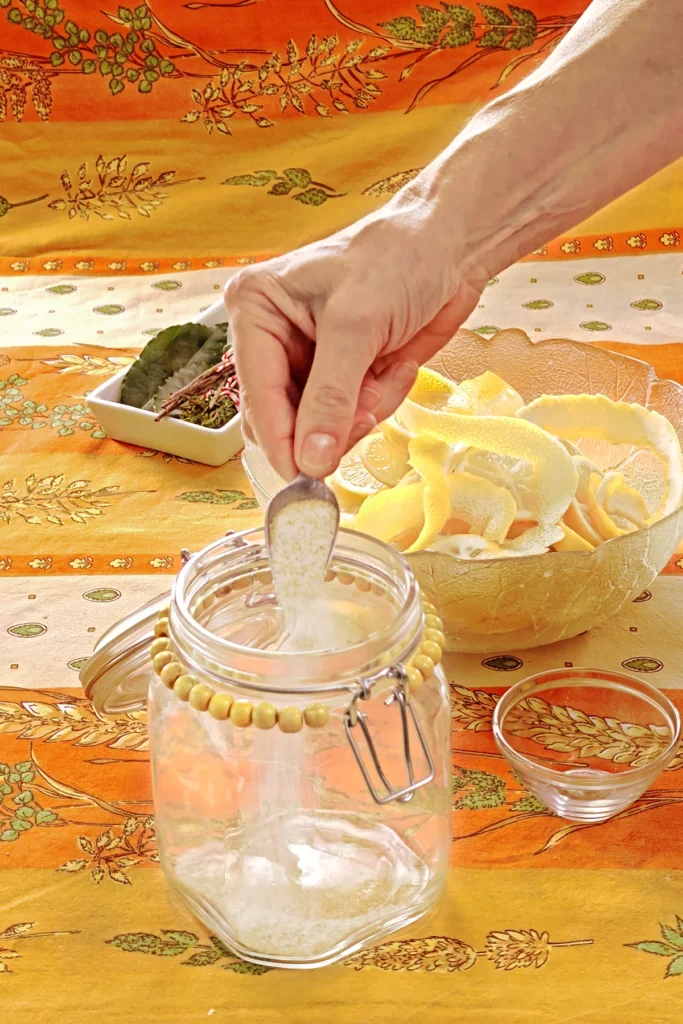
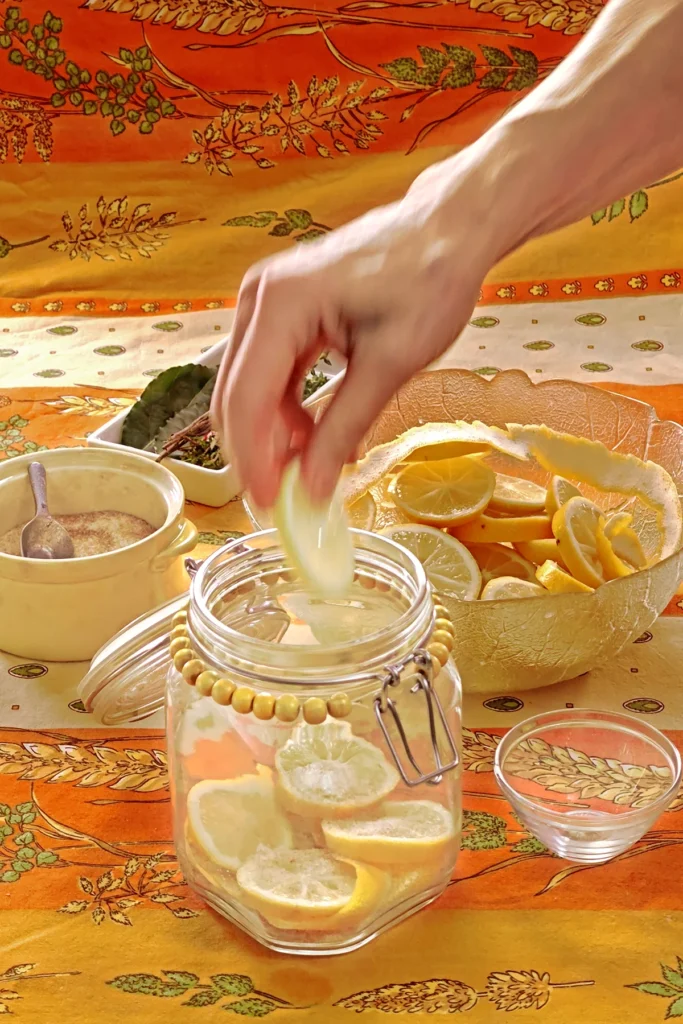
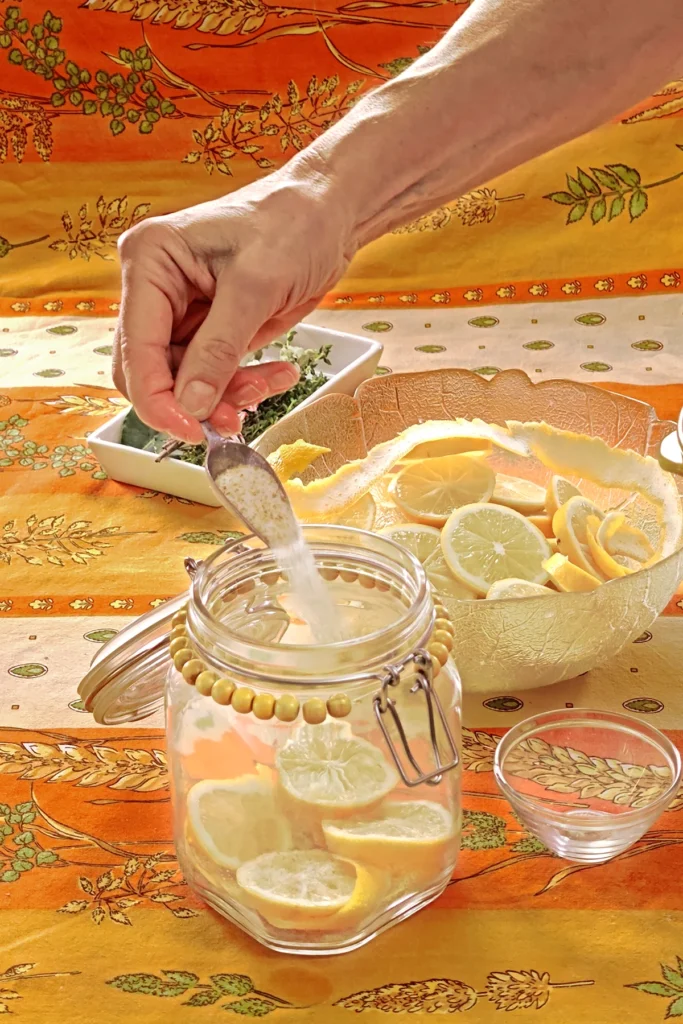
To know exactly how much salt and sugar is needed, weigh the fruit you want to ferment. Then calculate 2% of its weight—that’s the minimum amount of salt you need. I preferred to take a little more, I have used 3% salt for the recipe. A quick calculation: My fruits weighed 700g, of which 3% is 21g. So I used 21g of salt, a third of which was sugar, which means I needed 7g of sugar. Now, mix the salt and sugar in a bowl. Then, take the freshly cleaned preserving jar and add two spoonfuls of the salt mixture first, then start layering. Take the lemon slices/peel and alternate layers of lemon and salt mixture. Sprinkle the salt generously between the layers.
Herbs or Spices:
If desired, you can introduce additional flavors by adding the washed herbs and peppercorns in between. I think the hero in this recipe is the lemon alone. In my opinion, the herbs/spices are more of a decorative nature. Especially if you want to give such a jar as a gift, they look very nice with the addition.
Glass Fermentation Weights (or a Small Glass Bowl):
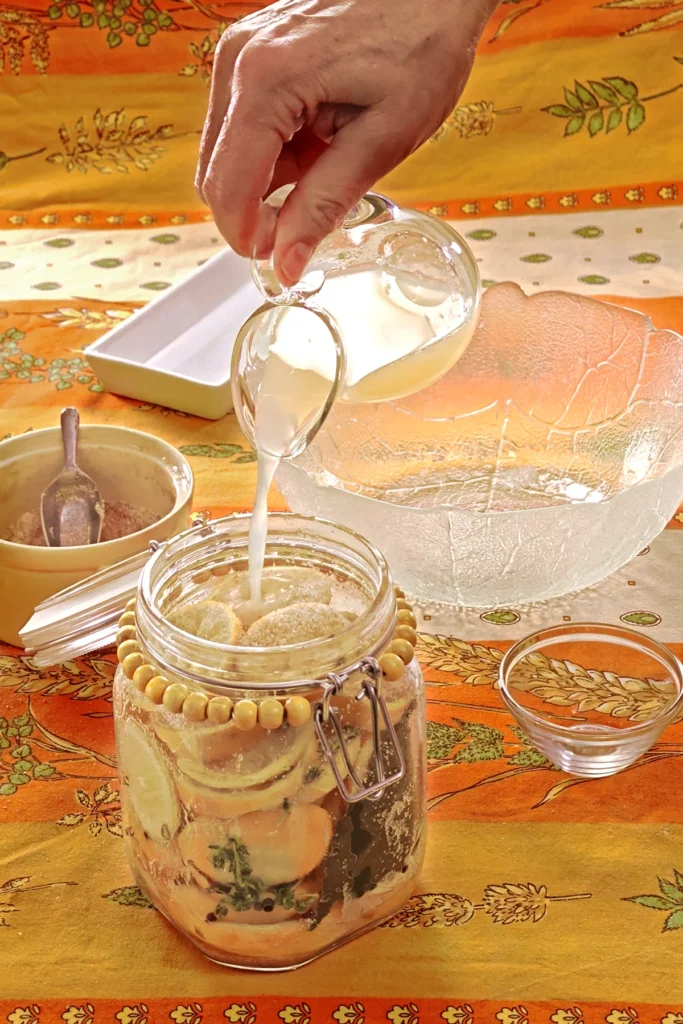
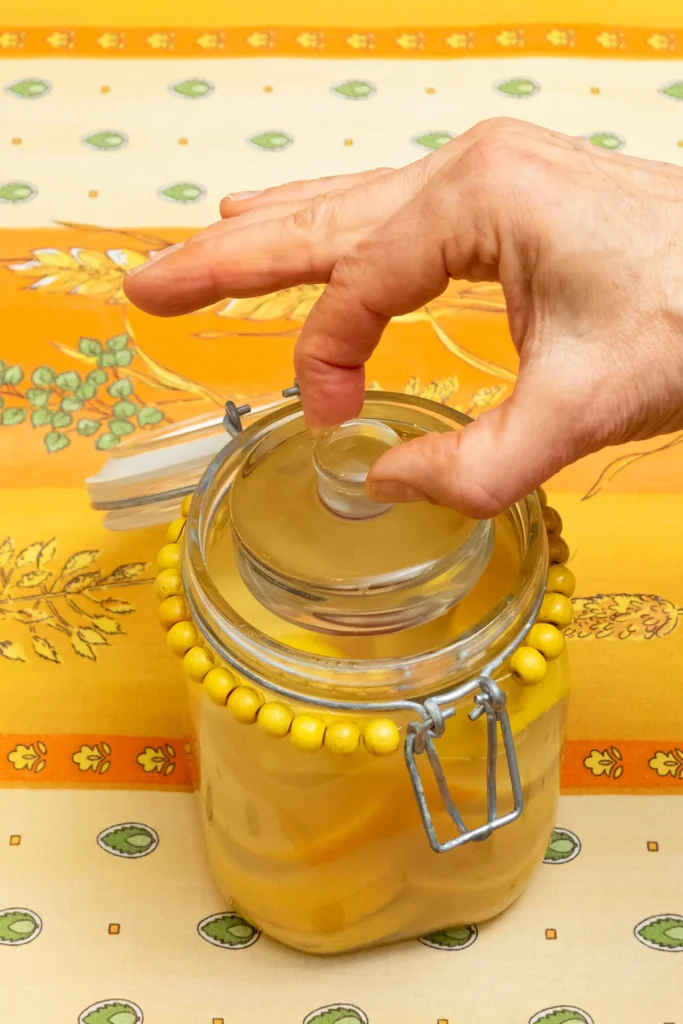
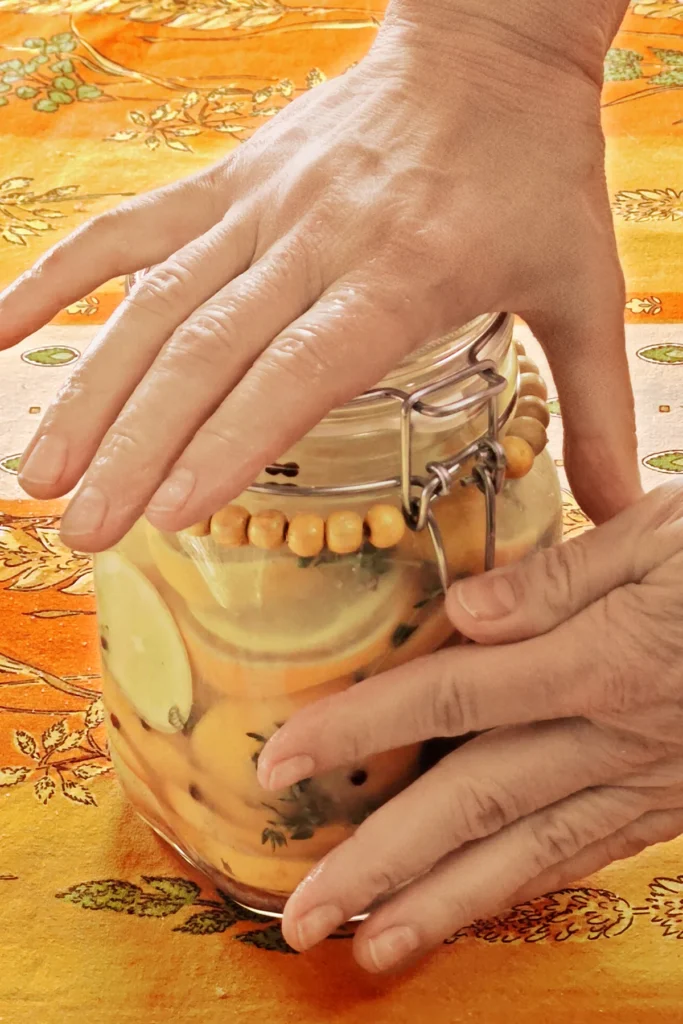
Finally, fill the jar almost to the top, pour in the lemon juice, and press the fruit under the liquid using a ferment glass weight (or a glass bowl). Always ensure the lemons stay submerged in brine to prevent mold! If there is not enough liquid to fully cover the lemons right away, close the jar anyway and wait a day. The salt will gradually draw the liquid out of the flesh, which should cover the lemons in their own juice. If there isn’t enough liquid after a day, pour in cooked water until the brine fully covers all the slices.
If you have an old jar of preserved fermented lemons, you can take a few tablespoons of the juice and add it to your new jar. The beneficial bacteria in the old brine will help speed up the fermentation process in the new jar.
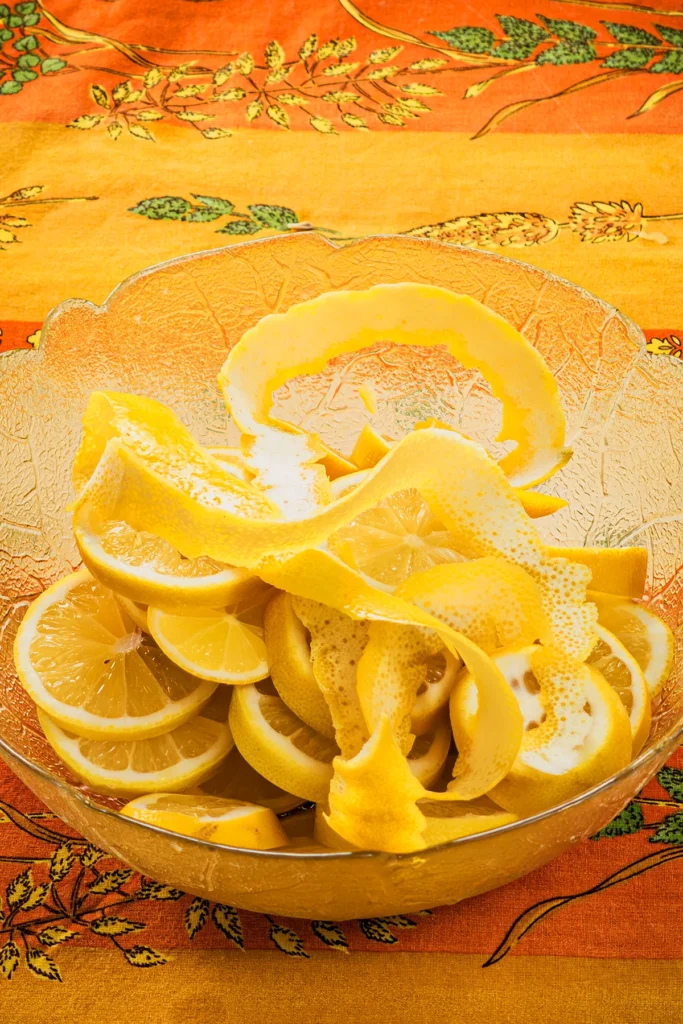
Monitoring the Fermentation Process for around 3 to 4 weeks:
Now, patience is key: Swirl the jar every three days to distribute the liquid evenly. This also helps release CO₂ gas to the top. As long as the lemons stay fully submerged in the brine, the fermentation remains safe.The brine protects the lemons from oxygen and prevents unwanted microorganisms from visiting.
Every three days, you should open the lid of the jar very briefly to release excess CO₂. The gas is produced during fermentation, and it is better to let it escape. Especially in tightly sealed jars with screw caps! Jars with a rubber ring seal usually regulate the pressure automatically. The rubber ring seal keeps oxygen from entering the jar while allowing the gas to escape. Still, I opened the handle briefly every three days, and the CO₂ puffed out, which somehow made me feel safer. If you can hear bubbles or a slight hiss, it indicates that the fermentation is active – a good sign! After around 3 to 4 weeks, fermentation is complete, so you can stop opening the lid regularly. Once the lemons are fermented fully, they will no longer develop significant pressure from CO₂.
Storage and Shelf Life:
After fermentation, you can simply store the lemons in the refrigerator. The cold will greatly slow the residual fermentation process and make the lemons last longer. It is important to keep the lemons completely covered by the brine! The brine will prevent mold from forming and keep the lemons fresh. Fermented lemons can be stored for several months, sometimes up to a year. Check for any signs of them turning bad, like weird taste, smell, or visible changes like mold! When in doubt, throw it out!
Preserved Lemon Purée:
Once your preserved lemons are fully fermented, you can slice off a piece whenever you need one, finely chop it on a cutting board, and stir it into your dish. However, there’s a much more convenient method: turning them into a purée!
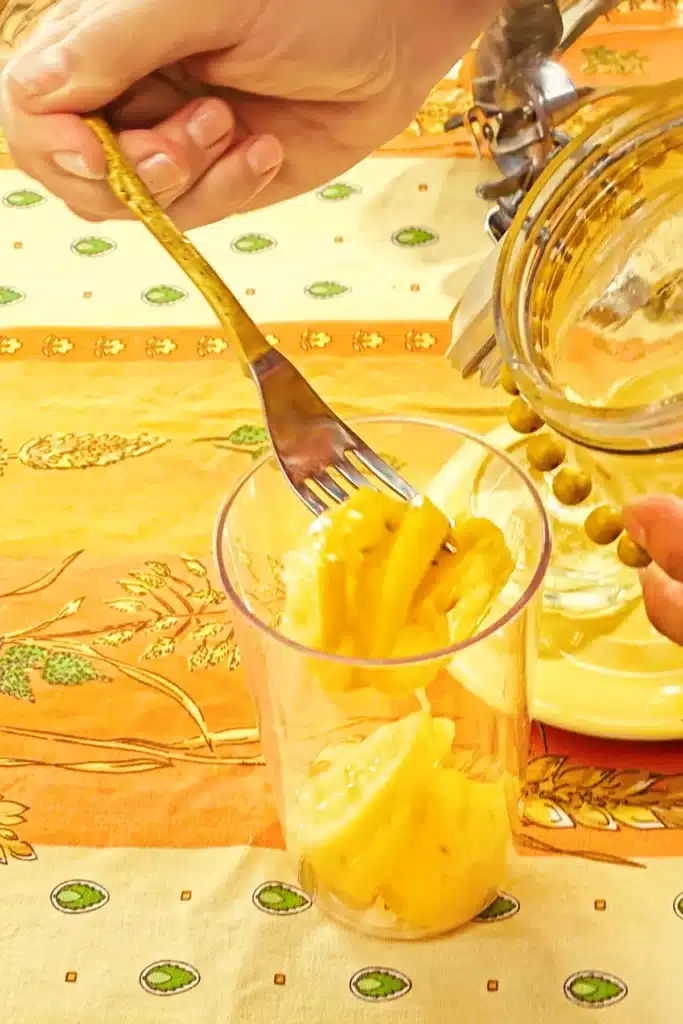



Simply take the entire batch of preserved lemons, including the brine, and blend everything into a smooth paste using an immersion blender. Then, transfer the purée to a clean jar with a screw-top lid. Finally, pour a thin layer of olive oil on top — this helps preserve your flavorful condiment. Whenever you want to season a dish or sauce with preserved lemon, just scoop out a bit of the purée with a clean spoon. Be sure to store the jar in the fridge.
FAQ:
Salt works as a preservative. The added salt removes moisture from the lemons, creating a brine. This brine also acts as a protective layer, inhibiting the growth of spoilage bacteria. After 3-4 weeks, the lemon juice in the jar becomes a viscous, syrupy juice. Don’t discard it, it is amazingly good for seasoning.
Over time, naturally occurring lactic acid bacteria found on the surface of the lemons start to ferment the lemons. This process produces lactic acid, which lowers the pH value of the lemons. It also preserves them and enhances their aroma with a unique flavor. The activity is supported by the lemons’ natural sugars. The added sugar is optional and primarily serves to adjust the taste and enhance fermentation. The color changes over time. The light yellow of the lemon peel becomes a dark yellow. Also, their peel texture softens.
Unrefined salt contains minerals that are important for the fermentation process. This includes primordial salt, Himalayan salt, and rock salt. They come from ancient salt deposits with no direct contact with today’s environmental pollution.
If you want to use sea salt, look for high-quality, tested products from trustworthy manufacturers. Sea salt is often contaminated with harmful microplastics due to ocean pollution.
Under no circumstances should salt with artificial anti-caking agents or additives (like iodine) be used for fermentation. Iodine can, for example, hinder the growth of important lactic acid bacteria.
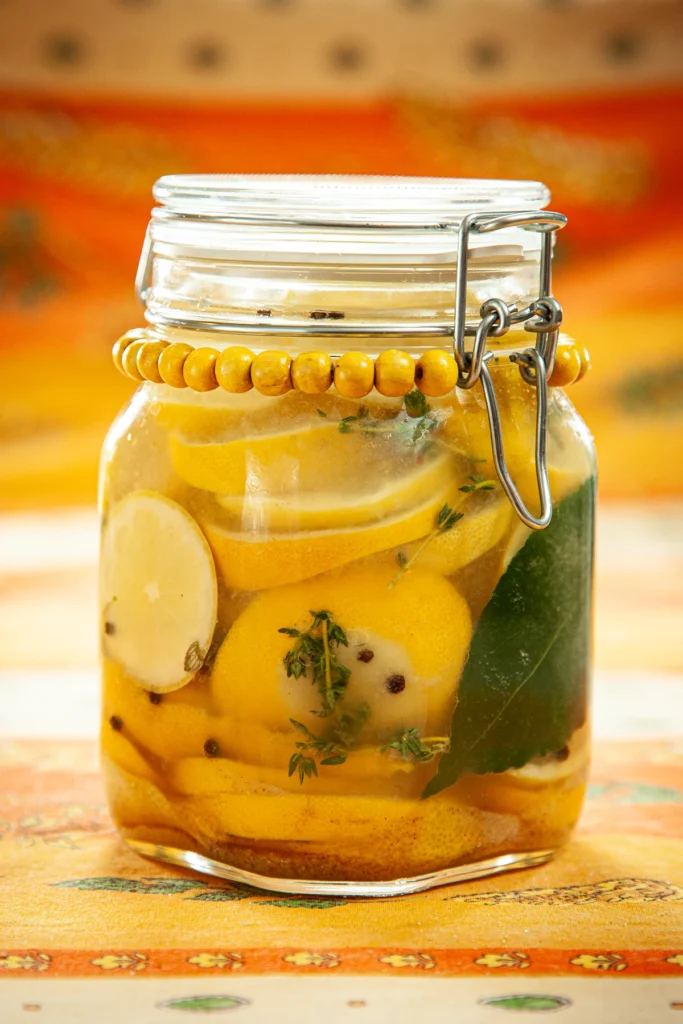
I hope you enjoyed this preserved lemons recipe. If you liked it, you might also enjoy our preserved oranges. They are just as simple to make! Let me know what you think in the comments below!
Some Recipe Suggestions:
- Preserved oranges recipe
- Pickled cauliflower
- Quick pickled radish
- Pickled Jalapeno recipe
- Pickled Garlic recipe
- Crunchy quick pickled carrots
- Delicious pickled beets recipe
- Do Chua Vietnamese pickle
- Fresh pickled red cabbage
- Pickled onions
Preserved lemons
Preserved lemons add tangy, salty flavor to dishes. Easy to make and ready in 3–4 weeks. They are such an enrichment in the kitchen!
- Total Time: 4 Weeks
- Yield: 700ml 1x
Ingredients
- 6 organic lemons
- 21g salt
- 7g sugar
Optional decoration:
- Thyme
- Oregano
- Bay leaf
- Peppercorns
Instructions
Preparing the Lemons
Wash the lemons with hot water. Rub them dry with a kitchen towel.
Cut four lemons into slices about 4-5 millimeters (approx. 2 inches) thick.
Remove the seeds and discard the end pieces.
Peel the remaining two lemons with a potato peeler and add the peel to the lemon slices.
Squeeze the juice out of these two peeled lemons with a citrus juicer.
Fill a Preserving Jar
Mix the salt and sugar in a bowl.
Add two spoonfuls of the salt mixture to the preserving jar and start layering.
Take the lemon slices/peel and alternate layers of lemon and salt mixture (2-4 teaspoons per layer).
Herbs or Spices
If desired, you can add washed herbs and peppercorns in between.
Glass Fermentation Weights (or a Small Glass Bowl)
Fill the jar almost to the top, pour in the lemon juice, and press the fruit under the liquid using glass weights. Ensure the lemons stay submerged in brine to prevent mold!
If there is not enough liquid to fully cover the lemons right away, close the jar anyway and wait a day. The salt will gradually draw the liquid out of the flesh, which should cover the lemons in their own juice. If it still isn’t enough liquid, you can top up with hot water until all the slices are completely covered under the brine.
Monitoring the Fermentation Process for around 3 to 4 weeks:
Swirl the jar every 3 days to ensure the liquid is well distributed and the lemons are completely covered by the brine. Also, you should open the lid of the jar very briefly every other day to release excess CO₂.
After around 3 to 4 weeks, fermentation is complete, so you can stop opening the lid regularly.
Storage and Shelf Life:
After fermentation, store the lemons in the refrigerator. It is still important to keep the lemons completely covered by the brine. Fermented lemons can be stored for several months, but it is always safe to check for any signs of them turning bad, like weird taste, smell, or visible changes like mold! When in doubt, throw it out!
Preserved Lemon Purée:
Take the entire batch of preserved lemons, including the brine, and blend everything into a smooth paste using an immersion blender.
Transfer the purée to a clean jar with a screw-top lid.
Pour a thin layer of olive oil on top.
Store the jar in the fridge.
Notes
Remember that the lemon slices are salty, so you can use less salt in your dish when adding these lemons.
- Prep Time: 30 Minutes
- Fermentation Time: 4 Weeks
- Category: Seasoning
- Method: Preservation
- Cuisine: African, Middle East
- Diet: Vegan
